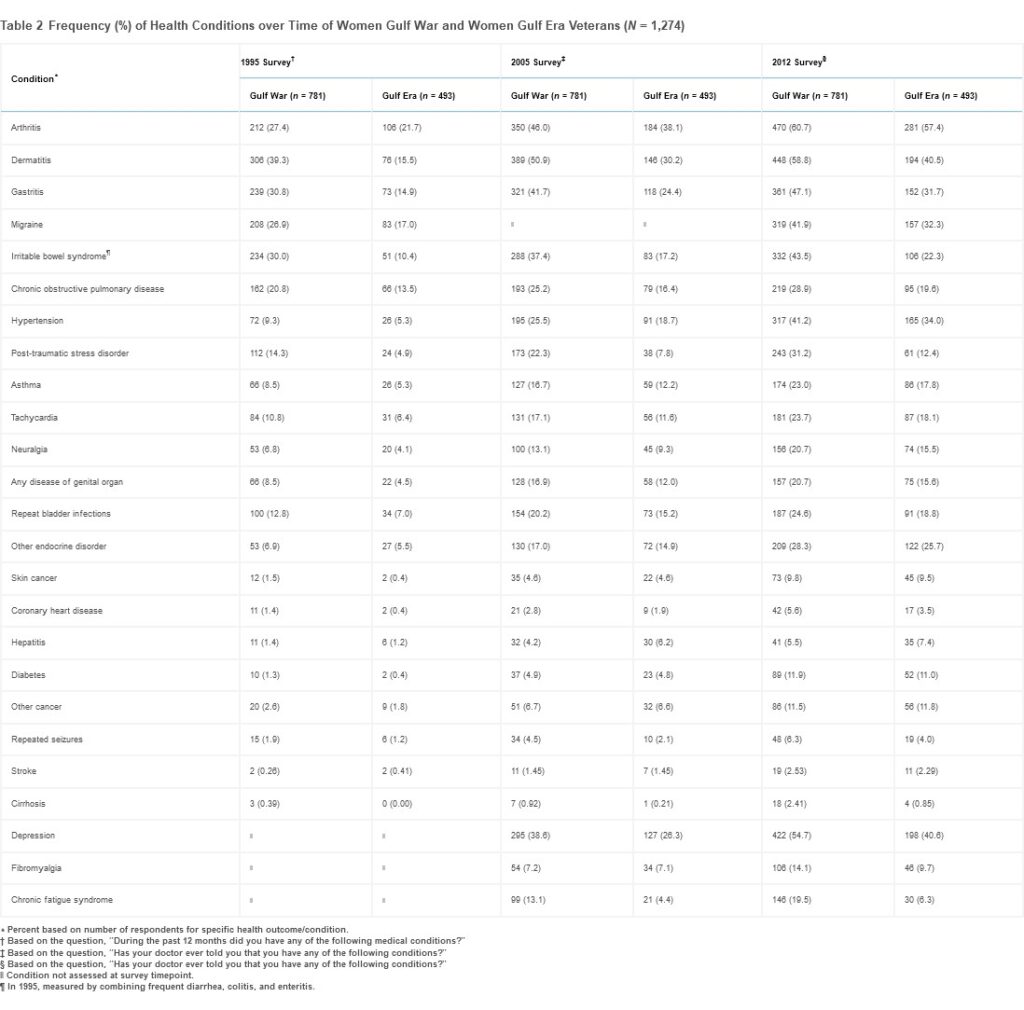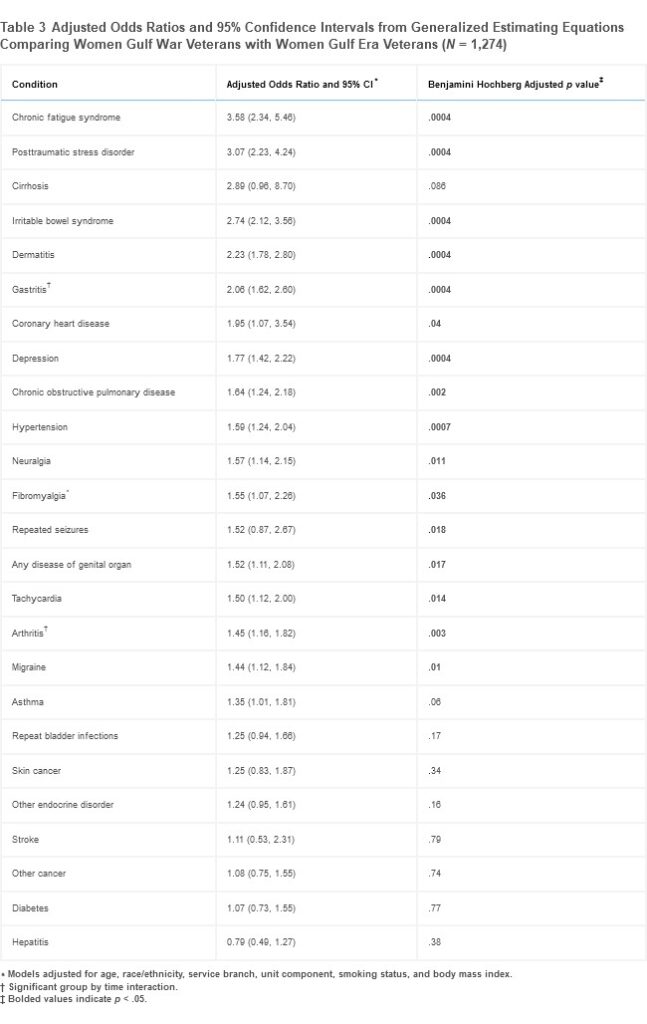WASHINGTON, DC—Women veterans who deployed to the 1990-1991 Gulf War report poorer health than Gulf War Era veterans who served during that time but didn’t deploy and women in the U.S. general population, according to a recent study.
The study published in the journal Women’s Health Issues compared the health of women Gulf War veterans and women Gulf Era veterans to the health of women in the U.S. general population over almost 20 years of follow-up. It is the first study to describe the health of women Gulf War veterans and women Gulf Era veterans over time and to make a comparison to women’s health in a civilian population, according to the study.1
The research team included researchers from the VA’s Washington, DC, office and the Hines, IL, VAMC.
The researchers used data from a health survey of 1,274 women Gulf War veterans and Gulf Era veterans who participated in the Gulf War Longitudinal Study and responded to all three waves of the survey. Data on the U.S. population of women came from the National Health and Nutrition Examination Survey (1999–2000, 2005–2006 and 2011–2014). The study compared the report of disease over time in women Gulf War and Gulf Era veterans. For the three survey timepoints, differences in prevalence of disease were calculated between women Gulf War veterans and women in the U.S. population and women Gulf Era veterans and women in the U.S. population, the study reported.
The VA Health Outcomes Military Exposures (HOME) has been following a group of 30,000 Gulf War Era veterans since 1995. The Gulf War Era Cohort Study is “the largest and longest study of veterans who served in the 1990-1991 Gulf War and has contributed greatly to our understanding of the health effects of service in this conflict,” according to the report.
The Gulf War Era Cohort Study was designed to have representation from all service branches, as well as the reserve and Guard, to reflect the composition of the military during the Gulf War. Women comprised 20% of the total sample, so there were enough women to make inferences about the population. Women veterans who responded to all three data collections were included in the current study, the study authors explained in an email.
“We looked at self-reported health at three different time points over the course of about 20 years,” lead author Erin Dursa, PhD, MPH, a researcher at the VA in Washington, told U.S. Medicine. “Overall, both women Gulf War and women Gulf Era veterans reported a lower prevalence of hypertension, stroke and diabetes than the U.S. general population sample, which came from the National Health and Nutrition Examination Survey. Women Gulf War and women Gulf Era veterans reported a higher prevalence of arthritis, COPD and skin cancer than the U.S. general population sample at all three time points.”
The findings suggest “there are things about military service and the exposures that are part of military service that may put women at risk for these conditions. Clinicians need to be aware of how military service impacts health,” Dursa wrote.
“Overall, I think the most important finding is that military service may associate with possible health effects for women, and deployment may amplify those effects,” Dursa said. “While both women Gulf War and women Gulf Era veterans demonstrated increased prevalence percent of disease over time, the magnitude was always greater in the Gulf War veterans, and for almost all 25 medical conditions, women Gulf War veterans had significantly higher odds of disease over time.”
This study is “the first to provide longitudinal analyses on women Gulf War and Gulf Era veterans over almost 20 years of follow-up and provides a comparison to civilian women in the general population,” Dursa explained.
Included VA Health Nonusers
“A unique feature of this cohort is that it includes both VA healthcare users and nonusers, capturing a group of veterans that is rarely studied in VA research and providing a more accurate estimate of the health of the entire population,” Dursa said. “The stratification by deployment status and the inclusion of the civilian comparison group provides greater dimension to explore the effect of military service in general (Gulf War Era) as well as deployment (Gulf War). It is the first study to report these comparisons in these three groups over time.”
The researchers sought to explore this topic because, “the health effects of military exposures on women, especially those who served in the 1990-1991 Gulf War, were unique because it was the first time that women were serving in a variety of military occupations.” The occupations ranged from medical positions to aircraft weapons assemblers and loaders. They were engaged in deployment-related tasks such as setting up and taking down tents, filling sandbags for building bunkers and burning human waste, which could impact health, Dursa explained.
In 2019, Dursa and her colleagues published a paper that compared the health of women veterans who had deployed to the 1990-1991 Gulf War to the health of women veterans who served during the Gulf War but did not deploy. The researchers found the 1990-1991 Gulf War veteran women had significantly worse health than the women veterans who did not deploy, which sparked interest in how the health of these women veterans would compare to the health of women who never served in the military, Dursa added.
The current study “demonstrates the value of epidemiological research on women veterans and the importance of developing longitudinal cohorts across genders that focus on the rigors of military service, potential military related exposures, deployment experiences, and factors associated with transition from service member to veteran,” Dursa said.
The researchers emphasize that it’s “important for any healthcare professional who is caring for women veterans to ask about their military service, their military occupation and their exposure concerns, as this may inform clinical care,” Dursa said.
Women veterans are the fastest growing demographic at VA. The VA has programs and services specifically for women veterans, which include primary care and comprehensive women’s health services. For information on services, eligibility and enrollment, providers and patients can visit.
- Dursa EK, Cao G, Culpepper WJ, Schneiderman A. Comparison of Health Outcomes Over Time Among Women 1990-1991 Gulf War Veterans, Women 1990-1991 Gulf Era Veterans, and Women in the U.S. General Population. Womens Health Issues. 2023 Jul 24:S1049-3867(23)00123-8. doi: 10.1016/j.whi.2023.06.006. Epub ahead of print. PMID: 37495424.



